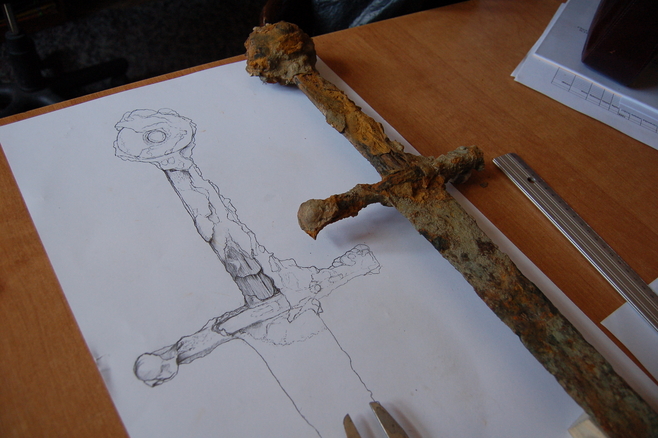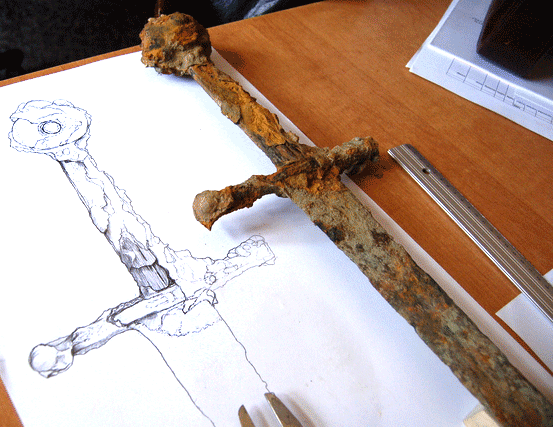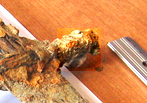| Author |
Message |
Michal Plezia
Industry Professional

|
 Posted: Mon 21 May, 2012 2:54 pm Post subject: The new sword found in the river, Biskupice R. near Tarnów. Posted: Mon 21 May, 2012 2:54 pm Post subject: The new sword found in the river, Biskupice R. near Tarnów. |
 |
|
A teenager has found a sword in the river of Dunajec near my hometown- Tarnów.

http://www.gazetakrakowska.pl/artykul/572643,...a-material
The article doesn't say much about the sword itself. The only useful information is that the lenght of the weapon is circa 120cm.
Do you have any ideas on the possible dating, typology etc? It looks like the handle is quite short.
www.elchon.com
Polish Guild of Knifemakers
The sword is a weapon for killing, the art of the sword is the art of killing. No matter what fancy words you use or what titles you put to
it that is the only truth.
|
|
   |
 |
Iagoba Ferreira

|
 Posted: Mon 21 May, 2012 3:08 pm Post subject: Posted: Mon 21 May, 2012 3:08 pm Post subject: |
 |
|
| Quote: | | It looks like the handle is quite short. |
I agree, seems to be around 15 cm, perhaps a bit more. That it is mineralized wood and even perhaps the leather covering?
|
|
  |
 |
|
Michael Parker
|
 Posted: Mon 21 May, 2012 5:29 pm Post subject: What a wonderful discovery! I have some suggestions. Posted: Mon 21 May, 2012 5:29 pm Post subject: What a wonderful discovery! I have some suggestions. |
 |
|
Hurray!  This is cause for celebration! What a lucky kid who found it, this is a wonderful gift from the river. This is cause for celebration! What a lucky kid who found it, this is a wonderful gift from the river.
My analysis is based on educated guesses and I've already formed my own stubborn mental picture of what I think this sword is like. Don't blame me, I just really like it and I'm inspired. I will go out on a limb and say this is a fine example of a war sword or even a lighter great sword of the high middle ages. Maybe I'm wrong and it's just a long, hefty single handed cavalry sword, but I like the former idea better. 1.2 meters is almost 4 feet, so by the standards of the high middle ages this is a very long sword! I think judging the teenager's hands the handle is shorter than a great sword like the albion Duke would have, but it doesn't look terribly short to me. I'm positively sure you could manage to fit your left hand on there especially if you put the heel of your hand on that nice wheel pommel.
The J type pommel suggests this sword is between the mid 13th and mid 15th century in terms of its age, and due to the blade type I bet this is a 13th or early 14th century sword. The blade looks to have a long and narrow parallel-sided profile and pretty thin. Since the blade is thin and fullered I bet this was a fierce, slicing chopper of a sword, though an un-armored opponent might be seriously run through. Maybe the blade is type XII or XIII; I can't see through the corrosion in the pictures where the fuller ends or how pointy the tip was. I wonder whether or not it has a peen block. Even in this corroded state of preservation this looks like a fine weapon made by a smith who knew what he was doing. The proportions of this sword just look really great to me. What a work of art.
These are my educated guesses and I will happily accept any alternate opinions from more experienced commentators. I'm excited with this find and I can't wait to hear more people's opinions!
"This is a sharp medicine, but it is a physician for all diseases and miseries."
-Sir Walter Raleigh, upon being allowed to see the ax that would behead him, 29 October 1618
|
|
  |
 |
Luka Borscak

|
 Posted: Tue 22 May, 2012 3:06 am Post subject: Posted: Tue 22 May, 2012 3:06 am Post subject: |
 |
|
|
The sword has an S curved guard so that pus it into later 15th or early 16th century.
|
|
  |
 |
|
Peter Johnsson
Industry Professional
|
 Posted: Tue 22 May, 2012 5:52 am Post subject: Posted: Tue 22 May, 2012 5:52 am Post subject: |
 |
|
A beautiful sword and a wonderful find.
I would love to learn more about it.
I fail to see any S-curve in the guard. To me it seems to be a fairly typical straight guard with a swell in the middle and flaring ends, possibly slightly octagonal in section towards the ends.
The blade may be a type XII or a type XVI: as the point is missing and the cross section not really clear this is difficult to make out with available information.
The grip is longer than most single handers, as is the blade. This means it should possibly be classified as a XIIa or a XVIa.
The slim outline of the blade and the bold proportions of the hilt makes it a very handsome weapon.
I would love to make an analysis of its proportions, but to do that I would need access to the tracing/drawing that is visible in one of the photos, plus some measurements to make interpretation more exact.
As to dating, it seems to be a late 13th to early 14th century sword from what is visible in the photographs.
|
|
   |
 |
Luka Borscak

|
 Posted: Tue 22 May, 2012 7:15 am Post subject: Posted: Tue 22 May, 2012 7:15 am Post subject: |
 |
|
|
I'm quite sure that it has a guard similar to guards on for example Albion Svante or Earl, but better pictures will hopefully show us more details.
|
|
  |
 |
Bill Grandy
myArmoury Team


|
 Posted: Tue 22 May, 2012 7:46 am Post subject: Posted: Tue 22 May, 2012 7:46 am Post subject: |
 |
|
| Luka Borscak wrote: | | I'm quite sure that it has a guard similar to guards on for example Albion Svante or Earl, but better pictures will hopefully show us more details. |
You know, I also assumed the guard was straight, but now that I've stared at the picture more, I think you might be right about the S shape. It is easier to tell when looking at the drawing. I hope they produce more pictures of this wonderful find!
HistoricalHandcrafts.com
-Inspired by History, Crafted by Hand
"For practice is better than artfulness. Your exercise can do well without artfulness, but artfulness is not much good without the exercise.” -anonymous 15th century fencing master, MS 3227a
|
|
   |
 |
Craig Johnson
Industry Professional

|
 Posted: Tue 22 May, 2012 7:47 am Post subject: Thank You Michal Posted: Tue 22 May, 2012 7:47 am Post subject: Thank You Michal |
 |
|
Thank you for sharing.
Nice sword. I think Peter's description covers it pretty well. I would love to get an x-ray of the hilt section. I particularly like the pommel shape. The length of grip is impressive and I would suspect this sword was meant for use from horseback.
Best
Craig
|
|
    |
 |
Luka Borscak

|
 Posted: Tue 22 May, 2012 8:24 am Post subject: Posted: Tue 22 May, 2012 8:24 am Post subject: |
 |
|
| Bill Grandy wrote: | | Luka Borscak wrote: | | I'm quite sure that it has a guard similar to guards on for example Albion Svante or Earl, but better pictures will hopefully show us more details. |
You know, I also assumed the guard was straight, but now that I've stared at the picture more, I think you might be right about the S shape. It is easier to tell when looking at the drawing. I hope they produce more pictures of this wonderful find! |
Yes, especially if you notice the right side is shorter but not broken and on the left side you see a round end of the cross which is curved towards the camera...
|
|
  |
 |
Sean Flynt

|
 Posted: Tue 22 May, 2012 8:25 am Post subject: Posted: Tue 22 May, 2012 8:25 am Post subject: |
 |
|
If the cross were re-curved, it would be done the wrong way. The (right) end that looks like it curves back would typically curve toward the viewer, the left side away from the viewer. But I'm not seeing a re-curved cross, either. I see a straight cross with a broken terminal on the right, with some concretion on the lower back side at the break. That arm is supported by a piece of eraser or putty for the table shot, and the poor lighting and resolution make it look like the putty is the terminal.
Here are some edited images (crop, brightness,contrast) that might help. If nothing else, they'll keep the images accessible in the thread.
 Attachment: 102.23 KB Attachment: 102.23 KB

 Attachment: 106.44 KB Attachment: 106.44 KB

 Attachment: 62.95 KB Attachment: 62.95 KB

-Sean
Author of the Little Hammer novel
https://www.amazon.com/Little-Hammer-Sean-Flynt/dp/B08XN7HZ82/ref=sr_1_1?dchild=1&keywords=little+hammer+book&qid=1627482034&sr=8-1
Last edited by Sean Flynt on Tue 22 May, 2012 8:43 am; edited 2 times in total
|
|
   |
 |
Luka Borscak

|
 Posted: Tue 22 May, 2012 8:30 am Post subject: Posted: Tue 22 May, 2012 8:30 am Post subject: |
 |
|
Well, I'm confused now but I also suddenly doubt my first impression. Maybe I'm imagining things. 
|
|
  |
 |
Sean Flynt

|
 Posted: Tue 22 May, 2012 8:36 am Post subject: Posted: Tue 22 May, 2012 8:36 am Post subject: |
 |
|
| Luka Borscak wrote: | Well, I'm confused now but I also suddenly doubt my first impression. Maybe I'm imagining things.  |
Not imagining, just studying  I did a double-take at the cross as well when I opened the thread. Some late re-curved crosses do have circular section and globular terminals and re-curve rather sharply. The missing terminal at right certainly does appear to curve back sharply, out of view, and the putty support in the shadows does give the impression that the piece is supported by a re-curved terminal. Without the drawing there, my quick first impression would have been of a re-curved cross and scent-stopper pommel. I did a double-take at the cross as well when I opened the thread. Some late re-curved crosses do have circular section and globular terminals and re-curve rather sharply. The missing terminal at right certainly does appear to curve back sharply, out of view, and the putty support in the shadows does give the impression that the piece is supported by a re-curved terminal. Without the drawing there, my quick first impression would have been of a re-curved cross and scent-stopper pommel.
-Sean
Author of the Little Hammer novel
https://www.amazon.com/Little-Hammer-Sean-Flynt/dp/B08XN7HZ82/ref=sr_1_1?dchild=1&keywords=little+hammer+book&qid=1627482034&sr=8-1
|
|
   |
 |
|
Jeremy V. Krause
|
 Posted: Tue 22 May, 2012 9:46 am Post subject: Posted: Tue 22 May, 2012 9:46 am Post subject: |
 |
|
|
Do conservationists usually remove the built up rust or simply leave it? The "lumpiness" makes it hard for me to conceptualize how the sword would look in period.
|
|
  |
 |
|
Peter Johnsson
Industry Professional
|
 Posted: Tue 22 May, 2012 10:06 am Post subject: Posted: Tue 22 May, 2012 10:06 am Post subject: |
 |
|
A good quality conservation will not only stabilize the metal and organic components, but also remove the built up material, revealing the original shape, or what is left of it.
I hope this sword is sent to an expert or a team of experts that can treat it as it deserves.
I have seen a single edged iron age sword that was handed in for conservation. It looked like a big clod of dirt. Very little telling it was a sword. After treatment, the sword was revealed in a surprising state of preservation, with quite a bit of original detail brought out.
I am curious to know how long the fuller is and what remains of the cross section of the blade. In the photos the blade looks like it could have been hexagonal in section originally.
|
|
   |
 |
Sean Flynt

|
|
   |
 |
Michal Plezia
Industry Professional

|
 Posted: Tue 22 May, 2012 11:02 am Post subject: Posted: Tue 22 May, 2012 11:02 am Post subject: |
 |
|
I've sent an e-mail to Mr.Szpunar from the museum. I hope we'll have more info soon.
Peter- the sword is in the hands of archeologists now. I'm sure they know what to do. 
www.elchon.com
Polish Guild of Knifemakers
The sword is a weapon for killing, the art of the sword is the art of killing. No matter what fancy words you use or what titles you put to
it that is the only truth.
|
|
   |
 |
|
Peter Johnsson
Industry Professional
|
 Posted: Tue 22 May, 2012 12:48 pm Post subject: Posted: Tue 22 May, 2012 12:48 pm Post subject: |
 |
|
| Michal Plezia wrote: | I've sent an e-mail to Mr.Szpunar from the museum. I hope we'll have more info soon.
Peter- the sword is in the hands of archeologists now. I'm sure they know what to do.  |
Michal: I will now be able to sleep tonight. :-)
Great if you can get some further information! Looking forward to hear what you might learn.
|
|
   |
 |
J.D. Crawford

|
 Posted: Tue 22 May, 2012 5:16 pm Post subject: Posted: Tue 22 May, 2012 5:16 pm Post subject: |
 |
|
In profile the blade looks like a rather large XI. Occassionally those had longer handles, although never before combined with this later hilt form (to my knowledge). It may be a trick of the corrosion, but that looks like a narrow fuller visible along the forte of the blade?
Definitely one to watch!
|
|
   |
 |
Robin Smith

|
 Posted: Tue 22 May, 2012 6:18 pm Post subject: Posted: Tue 22 May, 2012 6:18 pm Post subject: |
 |
|
| Sean Flynt wrote: | | Jeremy V. Krause wrote: | | Do conservationists usually remove the built up rust or simply leave it? The "lumpiness" makes it hard for me to conceptualize how the sword would look in period. |
AFAIK, it depends on importance of object, funding for conservation and stability. sometimes the concretion is the only thing holding the piece together. this looks pretty solid, though. |
So can a philanthropic group give donations with the stipulation that they be used specifically for A&A conservation and cataloging?
A furore Normannorum libera nos, Domine
|
|
   |
 |
Michal Plezia
Industry Professional

|
 Posted: Wed 23 May, 2012 5:01 am Post subject: Posted: Wed 23 May, 2012 5:01 am Post subject: |
 |
|
I've got a reply from Mr. Szpunar!
The sword is now in conservation in the laboratory in Głogów.
I was kindly given some stats and a close-up picture of the hilt.
| Quote: | stan zachowania: bardzo dobry, na głowni nieliczne odpryski korozyjne, większość powierzchni pokryta patyną, sztych zaokrąglony, z ubytkami, na trzpieniu rękojeści zachowane fragmenty okładziny drewnianej, na całej rękojeści przywarty piasek i różnej wielkości otoczaki z rzeki
wymiary (przed konserwacją): dłg. całkowita 122 cm
dłg. rękojeści 26,5 cm
szer. głowni u zastawy 5,3 cm
minim. szer. głowni 2,5 cm
szer. głowicy 7,2 cm
wys. głowicy 7,0 cm
dłg. jelca 20,8 cm
wys. jelca 2,3 cm
szer. trzpienia przy jelcu 4,5 cm
grubość jelca przy trzpieniu cm
grubość głowicy cm
|
My translation:
"state of preservation: very good, small number of rusty chips on the blade, most of the surface covered with patina, the tip rounded, with material losses, fragments of wooden grip preserved on the tang, sand and pebbles of various sizes clung to the handle.
Dimensions (before conservation):
overall length 122cm
hilt length 26,5 cm
blade width at the cross-guard 5,3 cm
min. blade width 2,5 cm
pommel width 7,2 cm
pommel height 7 cm
cross-guard length 20,8 cm
cross-guard height 2,3 cm
tang width at the cross-guard 4,5 cm
The last two without numbers are the thickness of the cross-guard at the tang and pommel thickness."
Unfortunately I had to resize the picture received from Mr. Szpunar, it was too big for imageshack.

www.elchon.com
Polish Guild of Knifemakers
The sword is a weapon for killing, the art of the sword is the art of killing. No matter what fancy words you use or what titles you put to
it that is the only truth.
|
|
   |
 |
|
|

